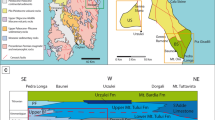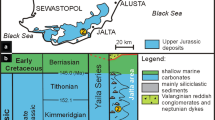Abstract
Synsedimentary crustification cements played an important role in the formation of Upper Carboniferous-Lower Permian skeletal mounds in the North Urals. In reef ecosystems, small or thin organisms covered with biofilms served as a substrate for hard cement crusts. Probably free-living sessile organisms couldn’t form frame constructions. However extensive, rapid posthumous biologically induced crustification of soft skeletons of organisms deposited over heterogeneous bioclastic material facilitates development of prominent hard frameworks on the sea-bottom in the slope environment.
Similar content being viewed by others
References
Antoshkina, A.I., Rifoobrazovanie v paleozoe: sever Urala i sopredel’nye oblasti (Reef Formation in the Paleozoic: The Northern Urals and Adjacent Regions), Yekaterinburg: Ural. Otd. Ross. Akad. Nauk, 2003.
Antoshkina, A.I., Evolution in the formation of reefs and biogenic skeletons during the Paleozoic in the northeast of the European Platform, Vestn. Inst. Geol. Komi Nauch. Tsentr, Ural. Otd. Ross. Akad. Nauk, 2008, no. 5, pp. 10–13.
Antoshkina, A.I., Biocementstone—an important component of organic structures of the Late Carboniferous-Early Permian (exemplified by the northern Urals), in Mat-ly 2 vseros. konf. “Verkhnii paleozoi Rossii: stratigrafiya i fatsial’nyi analiz”, 27–30 sentyabrya 2009 g. (Proc. 2nd All-Russia Conf. “Upper Paleozoic of Russia: Stratigraphy and Facial Analysis,” September 27–30, 2009), Kazan: Kazan. Gos. Univ., 2009, pp. 42–43.
Baturin, G.N., Fosfority na dne okeanov (Phosphorites on the Ocean Floor), Moscow: Nauka, 1978.
Bots, P., Benning, L.G., Rickaby, R.E.M., and Shaw, S., The role of SO4 in the switch from calcite to aragonite seas, Geology, 2011, vol. 39, no. 4, pp. 331–334.
Chuvashov, B.I., Permian reefs of the Urals, Facies, 1983, vol. 8, no. 1, pp. 191–212.
Chuvashov, B.I., Mizens, G.A., and Chernykh, V.V., Upper Paleozoic of the Shchugor River basin, in Mat-ly po stratigrafii i paleontologii Urala. Vyp. 2 (Materials for Stratigraphy and Paleontology of the Urals. Vol. 2), Yekaterinburg: Ural. Otd. Ross. Akad. Nauk, 1999, pp. 39–80.
Flügel, E. and Flügel-Kalher, E., Phanerozoic reef evolution: Basic question and data base, Facies, 1992, vol. 26, no. 1, pp. 167–278.
Flügel, E. Microfacies of Carbonate Rocks: Analysis, Interpretation, and Application, Berlin: Springer-Verlag, 2004.
Hardie, L.A., Secular variation in seawater chemistry: An explanation for the coupled secular variation in the mineralogies of marine limestones and potash evaporites over the past 600 m.y, Geology, 1996, vol. 24, no. 3, pp. 279–283.
James, N.P. and Bourque, P.A., Reefs and mounds, Facies Models, Response to Sea-Level Change, Walker, R.G. and James, N.P., Eds., St. John’s, NL, Canada: Geol. Ass. Canada, 1992, pp. 323–347.
Kiessling, W., Secular variations in the Phanerozoic reef systems, Phanerozoic Reef Patterns, Kiessling, W., Flügel, E., and Golonka, J., Eds., SEPM, Spec. Publ., vol. 72, Tulsa (OK): Soc. Sed. Geol., 2002, pp. 625–690.
Lyutoev, V.P., Antoshkina, A.I., and Ponomarenko, E.S., Paramagnetic markers of the formation stages of carbonate deposition in Palaeoaplysina biocementstone, in Mat-ly vseros. litol. soveshch. (Proc. All-Russia Lithol. Conf.), Syktyvkar: Inst. Geol. Komi Nauchn. Ts. Ural. Otd. Ross. Akad. Nauk, 2010, pp. 205–207.
Martin, R.E., Cyclical and secular variation in microfossil biomineralization: Clues to the biogeochemical evolution of Phanerozoic oceans, Glob. Planet. Change, 1995, vol. 11, nos. 1–2, pp. 1–23.
Martin, R.E., Secular increase in nutrient levels through the Phanerozoic: Implications for productivity, biomass, and diversity of the marine biosphere, Palaios, 1996, vol. 11, no. 3, pp. 209–219.
Ponomarenko, E.S. and Ivanova, R.M., Genesis of “vermicular limestones” in the Lower Permian Pisanyi Kamen’ skeletal mound on the Un’ya River (Northern Urals), in Mat-ly vseros. litol. soveshch. (Proc. All-Russia Lithol. Conf.), Syktyvkar: Inst. Geol. Komi Nauchn. Ts. Ural. Otd. Ross. Akad. Nauk, 2010, pp. 142–144.
Ponomarenko, E.S., Lithological-paleoecological characterization of the Lower Permian organic buildup Roza Kyrta Izpyred, Northern Urals, Litosfera, 2011, no. 3, pp. 50–63.
Ravikovich, A.I., A contribution to the characterization of Upper Paleozoic biohermic facies in the Pechora River basin (Un’ya River), Byull. Mosk. Ob-va Ispyt. Prir. Otd. Geol., 1956, vol. 31, no. 2, pp. 37–59.
Riding, R., Structure and composition of organic reef and carbonate mud mounds: Concepts and categories, Earth-Sci. Rev., 2002, vol. 58, no. 1, pp. 163–231.
Ries, J.B., Stanley, S.M., and Hardie, L.A., Scleractinian corals produce calcite, and grow more slowly, in artificial Cretaceous seawater, Geology, 2006, vol. 34, no. 7, pp. 525–528.
Ries, J.B., Effects of secular variation in seawater Mg/Ca ratio (calcite-aragonite seas) on CaCO3 sediment production by the calcareous algae Halimeda, Penicillus and Udotea—evidence from recent experiments and the geological record, Terra Nova, 2009, vol. 21, no. 5, pp. 323–339.
Sandberg, P.A., An oscillating trend in Phanerozoic nonskeletal carbonate mineralogy, Nature, 1983, vol. 305, no. 5929, pp. 19–22.
Sandberg, P.A., Nonskeletal aragonite and pCO2 in the Phanerozoic and Proterozoic, The Carbon Cycle and Atmospheric CO 2 : Natural Variations Archean to Present, Sundquist, E.T. and Broecker, W.S., Eds., Geophys. Monogr., vol. 32, Washington, DC: Am. Geophys. Union, 1985, pp. 585–594.
Senowbari-Daryan, B. and Flügel, E., Tubiphytes Maslov, an enigmatic fossil: Classification, fossil record and significance through time. Part 1: Discussion of Late Paleozoic material, in Studies on Fossil Benthic Algae: Proc. 5th Int. Symp. on Fossil Algae, Capri, Italy, April 7–12, 1991, Barattolo, F., De Castro, P., and Parente, M., Eds., Boll. Soc. Paleontol. Ital., Spec. Vol., no. 1, Modena: Mucchi, 1993, pp. 353–382.
Spencer, R.J. and Hardie, L.A., Control of seawater composition by mixing of river waters and midocean ridge hydrothermal brines, in Fluid-Mineral Interactions: ATribute to H.P. Eugster, Spencer, R.J. and Chou I-Ming, Eds., Geoch. Soc., Spec. Publ., no. 2, San Antonio: Geoch. Soc., 1990, pp. 409–419.
Stanley, S.M. and Hardie, L.A., Secular oscillations in the carbonate mineralogy of reef-building and sediment-producing organisms driven by tectonically forced shifts in seawater chemistry, Palaeogeogr., Palaeoclimatol., Palaeoecol., 1998, vol. 144, pp. 3–19.
Stanley, S.M., Influence of seawater chemistry on biomineralization throughout Panerozoic time: Paleontological and experimental evidence, Palaeogeogr., Palaeoclimatol., Palaeoecol., 2006, vol. 232, pp. 214–236.
Weber, J.N., Chloride ion concentration in liquid inclusions of carbonate rocks as a possible environment indicator, J. Sediment. Res., 1964, vol. 34, no. 3, pp. 677–679.
Weber, J.N., Temperature dependence of magnesium in echinoid and asteroid skeletal calcite: a reinterpretation of its significance, J. Geol., 1973, vol. 81, no. 5, pp. 543–556.
Yudovich, Ya.E., Seven genotypes of phosphatogenesis, Vestn. Inst. Geol. Komi Nauchn. Tsentra Ural. Otd. Ross. Akad. Nauk, 2006, vol. 6, no. 13, pp. 2–6.
Yudovich, Ya.E., Maidl’, T.V., and Ivanova, T.I., Geokhimiya strontsiya v karbonatnykh otlozheniyakh (v svyazi s problemoi geokhimicheskoi diagnostiki rifov) (Strontium Geochemistry in Carbonate Sediments (in Connection with the Problem of Geochemical Diagnostics of Reefs)), Yushkin, N.P., Ed., Leningrad: Nauka, 1980.
Zakharov, Yu.D., Boriskina, N.G., and Popov, A.M., Rekonstruktsiya uslovii morskoi sredy pozdnego paleozoya i mezozoya po izotopnym dannym (na primere severa Evrazii) (Reconstruction of the Late Paleozoic and Mesozoic Marine Environments from Isotope Data Using Northern Eurasia As an Exemple), Vladivostok: Dal’nauka, 2001.
Author information
Authors and Affiliations
Corresponding author
Rights and permissions
About this article
Cite this article
Antoshkina, A.I., Ponomarenko, E.S. Bioinduced crustification as a reaction of Late Carboniferous-Early Permian reef ecosystems to biosphere changes. Paleontol. J. 48, 1557–1568 (2014). https://doi.org/10.1134/S0031030114140044
Received:
Published:
Issue Date:
DOI: https://doi.org/10.1134/S0031030114140044




